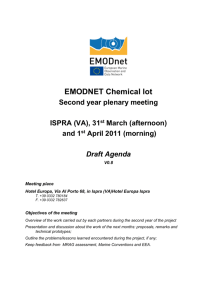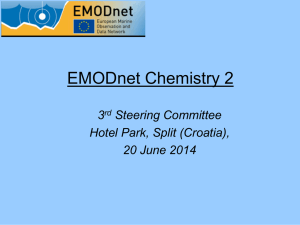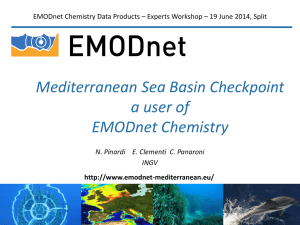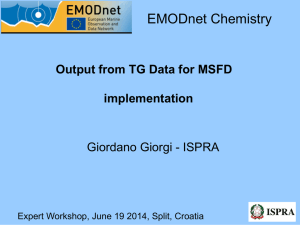EMODnet Biology 2
advertisement
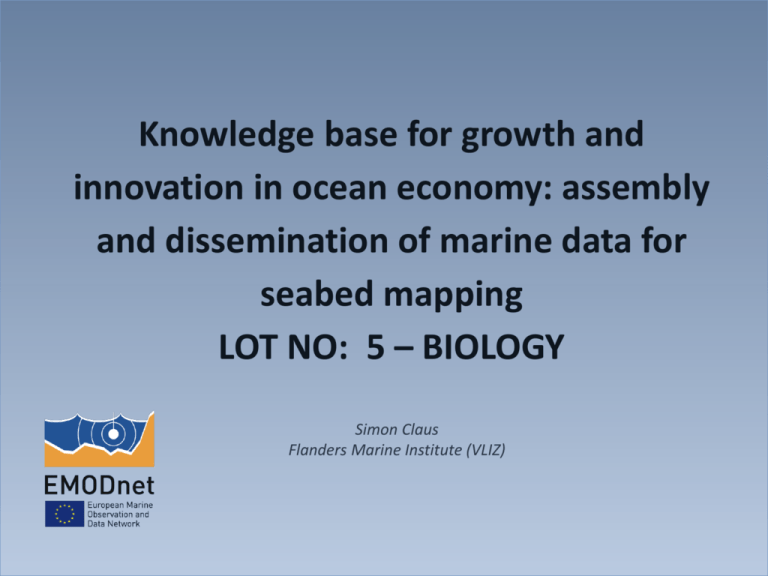
Knowledge base for growth and innovation in ocean economy: assembly and dissemination of marine data for seabed mapping LOT NO: 5 – BIOLOGY Simon Claus Flanders Marine Institute (VLIZ) Outline Presentation EMODnet biology preparatory phase (2009-2012) EMODnet biology 2 (2013-2016) 2 EMODnet March 14, 2016 The overall objectives biology 1 Temporal/Spatial distribution Phytoplankton, Zooplankton, Angiosperms, Macro-algae, Invertebrate bottom fauna, fish, Birds, Sea mammals, Reptiles. Parameters: Abundance, Biomass. Geographic Focus: North Sea incl. Kattegat, Channel; Bay of Biscay, Iberian Coast 9 partners (mainly data centres and marine biology data networks) 3 EMODnet March 14, 2016 The data portal system → Uses EurOBIS scheme for integrating spatio-temporal biogeographic data (Darwin Core) → Taxonomy matched with World Register of Marine Species → Geographic standards: OGC compliant, Marine Gazetteer for geographic names → Linked with global systems (OBIS-IODE/IOC-GBIF) 4 EMODnet March 14, 2016 International data flows 5 EMODnet March 14, 2016 Data records EMODnet 6 EMODnet March 14, 2016 Data inventory and gaps: EurOBIS Relative distribution Number of records per species group in EurOBIS (total=14.245.339) 7 EMODnet March 14, 2016 Data inventory and gaps 8 EMODnet March 14, 2016 The portal functionalities → Data querying (taxa; parameters, datasets, layers) Metadata View List Filter Download WoRMS 9 EMODnet March 14, 2016 The portal functionalities EMODnet March 14, 2016 The portal functionalities EMODnet March 14, 2016 The portal functionalities EMODnet March 14, 2016 The portal functionalities EMODnet March 14, 2016 The portal functionalities → Data visualization 14 EMODnet March 14, 2016 The portal functionalities → Data downloading 15 EMODnet March 14, 2016 The portal functionalities → Selected Data attributes from EurOBIS: WHAT? + WHERE? 16 EMODnet March 14, 2016 The portal functionalities → Selected Data attributes from EurOBIS: BY WHO? + WHEN? 17 EMODnet March 14, 2016 The portal functionalities → Selected Data attributes from EurOBIS: HOW MANY? 18 EMODnet March 14, 2016 Data inventory and gaps: Taxonomic Quality control 19 EMODnet www.marinespecies.org March 14, 2016 Data inventory and gaps: Geographic Quality control Communication with provider Data inventory and gaps: national long term monitoring 21 Country Sweden Denmark Germany Netherlands Belgium United Kingdom Ireland France Spain Portugal EMODnet Groups benthos, plankton, mammals benthos, plankton, algae, reptiles, mammals benthos, plankton, algae, birds, mammals benthos, plankton, birds, plants, mammals, bacteria benthos, birds, mammals benthos, plankton, birds, algae, reptiles, mammals benthos, plankton, birds, algae, mammals benthos, plankton plankton (benthos), phytoplankton, shellfish Temporal scope 1971 - present 1976 - present 1974 - present 1956 - present 1979 - present 1970’s - present 1970’s - present 1980’s - present 1987 - present ? March 14, 2016 EMODnet Biology 2 (2013-2016) Build further upon Biology I - 21 partners Kick off 11-12 September 2013 22 EMODnet March 14, 2016 Objectives The biological portal should provide data and metadata on surveys in the water column and on the sea-bed from each of the following groups of marine species, hereafter called categories:(1) phytoplankton(2) zooplankton(3) angiosperms(4) macro-algae(5) invertebrate bottom fauna(6) birds (surface observation at sea and coastal nesting)(7) mammals(8) reptiles(9) fish. The portal should provide free access to all the data and metadata obtained within the EurOBIS database and other separately managed databases. The strategy should not be to maintain all these data within one database but to provide access to them (WP3, WP4) Special attention should be given to those species and communities (habitats) which are protected by EU Directives and international conventions, and those to be used as indicators for Marine Strategy Framework Directive (WP2) For at least three species of each of these species groups, a gridded set of map layers should be produced showing the average abundance of the species in a set of time window. The portal should also calculate spatially distributed data products specifically relevant for Marine Strategy Framework Directive Descriptor 2 (non-indigenous species) based on guidance provided by the MSFD Common Implementation Strategy (WP5) This list does not include commercial fish species which are dealt with separately under the Data Collection Framework and do not need to be considered here although the portal should be able to accept data stream from the data Collection framework should that be made available. (WP6) 23 EMODnet March 14, 2016 Outline Presentation EMODnet Biology 2 (2013-2016) 24 EMODnet March 14, 2016 Outline Presentation Budget: Total 1,700 000 Euros Tasks Percent of total budget Project management 9,4 % Identification and collection of species, species attributes and species indicator information Data access to marine biological data 14,7 % Data archaeology and rescue 8,2 % Creation of gridded abundance data products 17,6 % Technical development 10,6 % Organisation scientific workshops and meetings 8,2 % Total 100 % 31,2 % 25 EMODnet March 14, 2016 EMODnet Biology 2 (2013-2016) WP 2: Identification and collection of species, species attributes and species indicator information Objectives The general aim of this work package is to streamline the data and data products that will be collated and created during the project, in line with the priorities that are developed under EU Directives and international conventions. The link will be met by identifying and focusing on the relevant species, communities, indicators and data types identified under the Marine Strategy Framework Directive. This work package will extend its work to collect and store information on different managerial, functional, and structural species attributes in a structured and accessible manner. This is to ensure that the resulting information can be integrated into the querying tools of the EMODnet Biology portal increasing the portals performance for targeted search by different user groups. 26 EMODnet March 14, 2016 EMODnet Biology 2 (2013-2016) WP 2: Identification and collection of species, species attributes and species indicator information (MBA) WT 2.1: Identification of species and species attributes information D2.1 List of species tagged with role and importance within MSFD reporting and the linked descriptor for inclusion in ERMS/WoRMS (M6). D2.2. Assessment of those species and communities identified by national MSFD leads as required for MSFD monitoring and reporting (M18) WT2.2: Collection of species attributes information D2.3: Organization of a data attributes workshop to discuss a standardized vocabulary and prioritize the biological attribute and trait information, in collaboration with WoRMS taxonomic editors (M6). D2.4: Publication of proposed standardized species attributes vocabulary (M24). D2.5: Selected European marine species tagged with relevant species attributes information and available through WoRMS and on the EMODnet biological portal (M36). 27 EMODnet March 14, 2016 EMODnet Biology 2 (2013-2016) WP3: Data access to marine biological data Objectives The objective of Work package 3 is to provide data and metadata on surveys in the water column and on the seabed from the different groups of marine species (phytoplankton, zooplankton, macro-algae, angiosperms, benthos, birds, mammals, reptiles and fish). These databases where identified during the data inventory and gap analysis that was performed during the pilot project of EMODnet biology and represent Europe’s largest marine biological data collections covering all trophic levels of the marine ecosystem. 28 EMODnet March 14, 2016 EMODnet Biology 2 (2013-2016) WP3: Data access to marine biological data (VLIZ) Activities: Analyse and assess in-depth the usability and fitness for purpose of the different data Country Sweden Denmark Germany Netherlands Belgium United Kingdom Ireland France Spain Portugal Groups benthos, plankton, mammals benthos, plankton, algae, reptiles, mammals benthos, plankton, algae, birds, mammals benthos, plankton, birds, plants, mammals, bacteria benthos, birds, mammals benthos, plankton, birds, algae, reptiles, mammals benthos, plankton, birds, algae, mammals benthos, plankton plankton (benthos), phytoplankton, shellfish Temporal scope 1971 - present 1976 - present 1974 - present 1956 - present 1979 - present 1970’s - present 1970’s - present 1980’s - present 1987 - present ? Format the data and perform data standardizations D3.1: Assessment of data and databases, including list of datasets that will be used for creation of products (M6) D3.2: Data standardization and formatting of all datasets mentioned under data coverage section of proposal for linking with EMODnet biology (M6-M36) 29 EMODnet March 14, 2016 EMODnet Biology 2 (2013-2016) WP4: Data archaeology and rescue (IBSS) Activities: Gap analyses and inventory of historical data that are at risk of being lost Run of small grant system Implementation of mechanism to ensure continuous inflow of datasets in the future D4.1: Report on data availability and gap analyses for the Black Sea M9 D4.2: Description of identified historical datasets M12 D4.3: Report describing the datasets that are digitized, standardized and mobilized into system including dataset documentation and QC procedures applied M24 D4.4: Workshop report including description of mechanisms and guidelines on mobilization of historical data into the systems M36 EMODnet March 14, 2016 EMODnet Biology 2 (2013-2016) WP5: Creation of gridded abundance data products (NIOZ) Objectives A set of gridded map layers will be produced showing the average abundance of at least three species per species group for different time windows using geospatial modeling. In addition, spatially distributed data products specifically relevant for Marine Strategy Framework Directive Descriptor 2 (non-indigenous species) will be created. The methodology will be prepared in generic way, allowing the calculation of spatially gridded quality indicators or summary statistics where these are needed for MSFD. This work package will receive input from WP2, on the choice of most relevant indicator species and will receive spatial species abundance data from WP3. It will receive additional environmental information from other lots of EMODnet, e.g. on benthic habitat characteristics and water masses, to be used as co-factors in the gridding. 31 EMODnet March 14, 2016 EMODnet Biology 2 (2013-2016) WP5: Creation of gridded abundance data products Activities: To implement a methodology, based on Data-Interpolating Variational Analysis (DIVA, ULg), to produce statistically optimized gridded map layers. To produce gridded map layers showing the average abundance of at least three species per species group in a given time window (seasonal, annual or multi-annual as appropriate). To estimate the accuracy of the gridding procedure by comparison with validation data. To complement with indications of the precision of the result based on the distribution of the basic data. To produce spatial maps (data products) specifically relevant for Marine Strategy Framework Directive Descriptor 2 (non-indigenous species - Mnemiopsis leidyi). D5.1: Data products for three sea basins (M12) D5.2: All data products (M24) 32 EMODnet March 14, 2016 EMODnet Biology 2 (2013-2016) WP6: Technical update EMODnet biological portal & link with other portals 33 EMODnet D6.1 Portal operational (Month 12) D6.2: Portal fine-tuned for convergence with EMODnet central portal (M36) D6.3: Maintenance of Portal (M12-M36) March 14, 2016 EMODnet Biology 2 (2013-2016) WP6: Technical update EMODnet biological portal & link with other portals The EMODnet biological portal will be able to provide links to metadata, data and data products for different systems by establishing direct machine-to-machine connections. The portal will be able to handle different data protocols for handling marine biological data by implementing different data standards. Species occurrences data can be made available using the Darwin Core standard that is in use by GBIF and OBIS. The Integrated Publishing Toolkit (IPT. The geospatial data can be made accessible through the EMODnet biological portal through several OGC Webservices Extension Biological dataformat within SeaDataNet infrastructure. 34 EMODnet March 14, 2016 Thank you 35 EMODnet March 14, 2016
